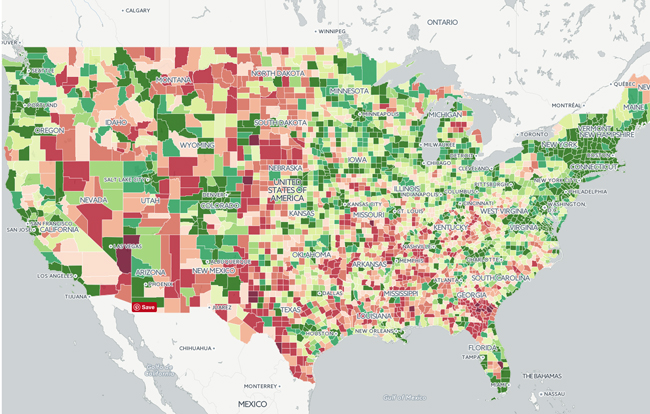How Arts Vibrant Are America's Cities? Here's Every County Ranked in an Interactive Map

The 2017 NCAR Arts Vibrancy Index ranks the most vibrant arts cities in America. How is the rest of the country fairing when it comes to arts vibrancy?
NCAR provides scores for every U.S. county on our interactive map based on measures of arts dollars, arts providers, government support, and socio-economic and other leisure characteristics. The scores are on a scale of 0-100 with 100 being highest. The scores are akin to percentiles - i.e., if your county's score on a measure is 56, it means it did better than 56% of counties on that measure. The map also allows you toggle through the top counties in U.S. to view the Large, Medium, and Small metro areas.
Evidence shows that arts and cultural organizations in the U.S. are well-distributed across the country, serving communities both poor and affluent, rural and urban, not just on the coasts and not just in major metropolitan markets.3 In this report, we highlight and celebrate communities of every size and in every region that have cultivated higher levels of arts activity per person living in the community. We use the term “vibrancy” in keeping with MerriamWebster’s definition of the word to mean “pulsating with life, vigor, or activity.”
See the Interactive Map | Download the Report
“In the current climate, it is more important than ever to recognize the vital role that the arts play in creating dynamic places to live, work, and visit, and the Arts Vibrancy Index shows us that this is the case in communities all across the country, not just in large cities and on the coasts,” said Dr. Zannie Giraud Voss, director of NCAR. “The index helps us understand what factors contribute to making an urban area artistically vibrant and culturally rich, and illustrates how vibrancy manifests in a wide variety of forms that are often tied to that community’s unique identity.” The report complements each listed community’s scores with its story of what makes it unique and dynamic.

Beyond the specific rankings, select findings in the Arts Vibrancy Index include:
- Every region of the country is represented in the index: Arts vibrancy is not exclusive to large, coastal metropolitan areas—cities large and small from every region appear in the index. While large and medium metropolitan areas are represented in all regions of the country, the list of small communities is dominated by those located in western (Alaska, Colorado, Montana, Utah, Wyoming) and northeastern states (Massachusetts, New York, and Vermont).
- Rankings of communities that have previously made the list are in constant flux: Many factors contribute to these shifts, including transformations in a city’s cultural scene (for example, through the opening of a large arts center), changes in population size, or the extent to which a city’s cultural activity can attract or involve its neighboring communities.
- Arts vibrancy takes many shapes and forms. Some communities have large, impressive nonprofit cultural institutions (e.g. Los Angeles, Denver, Newark, and Santa Fe), some have an abundance of smaller organizations and venues (e.g. Asheville, NC; Juneau, AK; and Missoula, MT), while others are particularly attractive to artists (e.g. Breckenridge, CO and Bozeman, MT) or to tourists (e.g. Barnstable Town, MA and Vineyard Haven, MA). Some cities are robust and strong in a variety of arts sectors (e.g. Pittsfield, MA), while others excel in one particular art form (Nashville). Some communities also received high levels of government support, including Minneapolis/St. Paul, New York, and Summit Park, UT.
- Vibrancy in very large cities takes two distinct forms: Some cities feature a strong concentration of arts vibrancy in the urban core with less going on in the surrounding areas (e.g. Chicago and Philadelphia), while others feature vibrancy distributed evenly throughout the larger metropolitan area (e.g. Boston and Cambridge).
- The majority of arts-vibrant cities have a population either under 300,000 or between 1,000,000 and 3,000,000. This finding holds true even after analyzing medium and small communities separately.